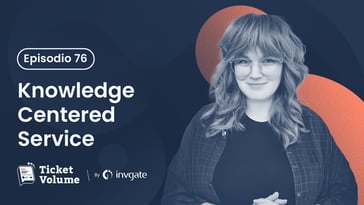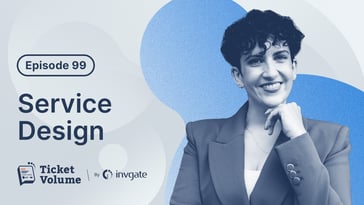First of all, there is no such thing as “best practices” in IT. It is a very volatile industry so change and transformation are necessary. Believing in good practices, on the other hand, is the mindset of a great leader who knows there is no room for improvement if something is truly “the best”.
Daniel Breston reminded us of just that on the 24th Episode of Ticket Volume, our IT podcast; where he had the opportunity to delve into the caveats of viewing Value Stream Mapping as a leadership tool. He is a retired coach, blogger, speaker, and writer with extensive experience in IT service and support management. He knows a thing or two about changes in the industry since he’s been working in it for over 50 years. So buckle up, he has seen everything and has a lot to say.
You'll find a clear and concise summary of the episode as you continue reading. However, when you have the opportunity, make sure to fully enjoy the entire thing as it is truly a gem. And, remember you can also participate in our monthly live sessions and ask your questions in real-time!

Value Stream Mapping as a Leadership Tool
Breston changed the way he did Value Stream Mapping and adopted a model from Karen Martin and Mike Osterling, which is nothing more than a leadership tool and it’s meant for leaders. In his words “leaders have to go down to see what’s going on.”
By going down to the gemba (the actual place where work is done), leaders can observe firsthand the challenges and opportunities within their value streams. This hands-on approach enables leaders to make informed decisions, drive change, and effectively lead their teams towards operational excellence.
|
|
"So, the ex-CTO of EE (...) spent 70% of his time outside of his office and not in meetings. He was in EE stores, he was with EE suppliers, he was with the places where EE made stuff, and he was looking to see how IT was helping or not helping. And, if he saw a problem, he went back to EE, he wrote it on a board, and gave it to a team and said: “can you all add this to your backlog? (...) We need to fix this.” and there was no shouting." Daniel Breston |
Here are some of the lessons the last few years of change for the IT industry have stuck with Breston the most.
1. Embracing collaboration and change
The power of the Chief Information Officer has significantly increased during the COVID-19 pandemic. As organizations were forced to quickly adapt to remote work and digital solutions, the CIO became a key figure in ensuring business continuity and enabling effective virtual collaboration.
The CIO plays a crucial role in organizations, and their efforts should be appreciated. Their expertise in managing technology infrastructure and data systems enables efficient operations and supports decision-making processes. The data provided by the CIO is essential for making informed choices that drive business success.
To truly optimize efficiency, it is important to partner with individuals who can contribute to improving processes and systems. Collaboration between HR and IT departments is particularly valuable, as it allows for a holistic approach to enhancing organizational performance.
Breston mentioned Greg Sanko, a respected industry expert, who emphasizes the importance of partnering with HR to achieve digital transformation goals. By aligning IT strategies with HR initiatives, organizations can effectively leverage technology to drive innovation and streamline operations.
Failing to prioritize these partnerships and neglecting the role of the CIO may result in criticism for merely using "digital transformation" as a buzzword. It is essential to recognize the significance of data-driven decision-making, appreciates the value of the CIO's contributions, and foster collaboration between HR and IT departments for long-term success.
2. The risk of enabling your team without guidelines
It is important to explain what you mean when empowering others. Breston said that empowering is quite a tricky concept that can do more harm than good. He refered to David Marquette's book Leadership Is Language to emphasize that empowerment should come with clear guidelines and expectations.
For instance, budget constraints could prevent your team from fully exploring their ideas despite being “empowered”. Too much freedom can have negative consequences if unexplained empowerment is your kind of leadership.
Imagine the frustration of losing staff due to budget cuts after being empowered with new tools. That’s why Breston advised IT managers to consider the impact of their actions on others and ensure that empowerment leads to positive changes.
3. Prioritizing tasks when there are multiple priorities
IT leaders are challenged with prioritizing tasks and learning from experiments. While it is acceptable to stop and learn from mistakes, it is crucial to avoid red cards (failures). Breston and Beran went ahead and highlighted the need to focus on Priority One tasks and discussed how treating everything as a Priority One can help address issues effectively.
Chaos and disorder may not arise if all efforts are directed towards addressing these high-priority tasks. This approach also encourages collaboration between different teams within an organization.
By assessing the impact of issues in different departments, you can effectively allocate resources based on priority and impact. This ensures that the most critical tasks are given the necessary attention and resources, leading to more efficient and effective outcomes.
Bottom line
This is a brief recap of the 24th episode of Ticket Volume with Daniel Breston, but there is much more of this discussion! Catch up on the full conversation with InvGate Product Specialist Matt Beran to learn about value stream mapping as a leadership tool for enhancing your IT management skills, and you may also enjoy some references to Batman and Sherlock Holmes.
You can find the full episode on Apple Podcasts, Spotify, YouTube, or your favorite podcast platform. Again, remember to subscribe if you want to be a part of the monthly live recordings!















